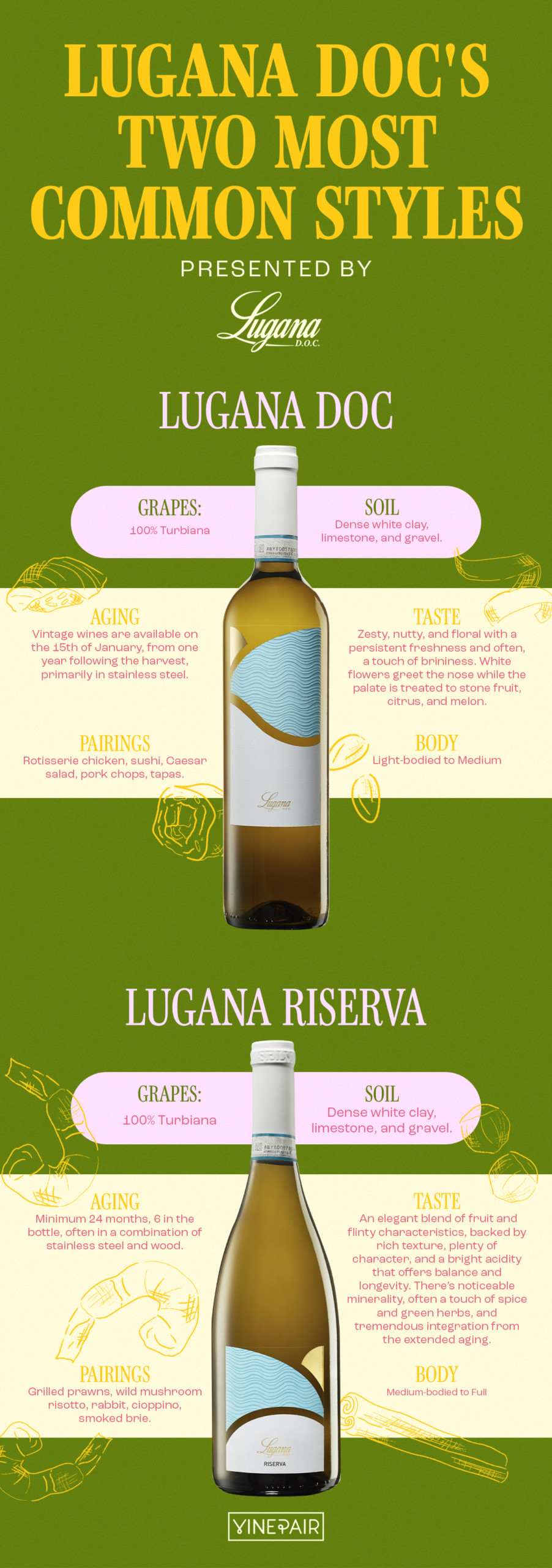![A Visual Guide to Lugana DOC Wine Styles [INFOGRAPHIC]](http://vinepair.com/wp-content/themes/vpcontent/images/blank.gif)
The Lugana DOC region is located on the southern side of the hyper-picturesque Lake Garda. Lugana is home to the Turbiana grape, which is a relative of Verdicchio and Trebbiano di Soave. Turbiana is getting some well-earned time in the limelight today, sought after by sommeliers and consumers alike. Considered one of Italy’s white wines that has aging potential, Turbiana reflects the region where it is grown.
Lugana’s moderate climate, impacted by Italy’s largest lake, is the ideal location for this up-and-coming white grape. The steady breezes keep vineyard rows well ventilated while the lake itself offers warmth to the fruit and its resulting wines. There’s very little drama here in terms of weather— unlike other locations in Northern Italy where extreme weather is more common — and that suits Turbiana just fine. But don’t for an instant think that mellow conditions lead to mellow wines.
In the glass, Lugana is a pleasant mix of finesse and vigor. There’s a tidy balance of sweetness and acidic punch, with aromatics so explosive you can practically see and hear them. It can remind some of a well-made Verdicchio or even a Fiano from the south of Italy, but again, Lugana wears its independent spirit on its sleeve. The wine can conjure up elements of other varietals but, as an entire creature, is really only like itself. Lugana is, well, Lugana and that’s a good thing.
The northern Italians have known as much for generations, sipping it alongside freshwater fish like pike in vegetable sauce or with a healthy portion of fresh ricotta. And while conditions above ground in this Italian region are usually calm, the scenario below ground is very different. In Lugana, densely compact clay soils test the vines, asking that they dig deep for nourishment and added complexity. The rows tend to mature more slowly but it’s always worth the wait, with the year’s yield offering a signature mix of flinty goodness and utter elegance. Few wine regions better emphasize the viticultural tagline, “The right amount of stress yields finesse.”
Strange to think that this land of plenty was virtually inhospitable long ago, draped in dense marshes and forests. Today, it’s a verdant plain overlooking an impossibly blue lake, flanked by dramatic mountain peaks. That plain and the surrounding morainic foothills are where Turbiana and the Lugana wines thrive, perfectly satisfied to enjoy the views, breathe in the freshness of the air, and bask in the calcareous soils. One visit and you’ll want to be deeply rooted here too.
One of the many merits of Lugana, and the higher-end or Riserva wines especially, is the texture. Extended skin contact and patient aging techniques produce white wines of incomparable weight and depth. One normally expects this kind of nuanced detail and ability to cellar from a tannic red. Sure, it’s easy to associate Italy with the immediate joy a fellow white wine like Pinot Grigio brings to the table. Yet, with Lugana, the experience is different. This is a lasting affair, with remarkable structure and a lasting impression. You can enjoy it year-round, pairing it with a number of dishes or simply on its own.
Like a good Riesling, Lugana can be aged to perfection, often for at least a decade (another trait we like to attach to red wines). Lugana Superiore, for example, is aged at least one year after it has been harvested. Golden in hue, Superiore is a step up in complexity and concentration and results in a deep palate with notes of wild herbs mingled with citrus fruits and ripe apples. It often has a higher minimum alcohol content and can be further matured in wood, adding a hint of toasted spice to its unique taste.
In total, there are five different styles of Lugana permitted: Lugana, Superiore, Riserva, Vendemmia Tardiva, which is a late-harvest or a sweet wine style, and a Spumante or sparkling version.
Whichever direction you head, the Turbiana grape will play the leading part, impressing you with its dynamic performance. If you don’t already have an appreciation for character-driven white wine, you soon will. And if you already do (Cin Cin!), here’s another showstopper to add to your list.
Here’s a handy breakdown of two prominent Lugana wine styles:
 This article is sponsored by Lugana DOC.
This article is sponsored by Lugana DOC. 
![Learn about the Turbiana grape from the Lugana DOC region and its two prominent wine styles with this handy visual guide. A Visual Guide to Lugana DOC Wine Styles [INFOGRAPHIC]](https://vinepair.com/wp-content/uploads/2022/02/lugana_card.jpg)